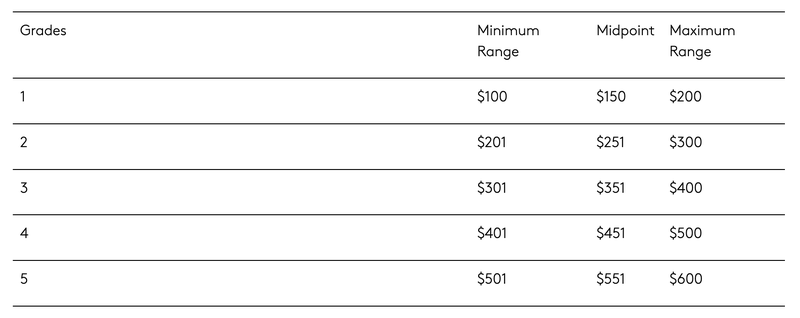Staff Compensation FAQs & Glossary of Terms
Glossary of Terms
Compensation Grade
This is an identifier of a range and multiple jobs can be grouped into the same grade. Our staff structure consists of 13 grades.
Compensation Range
Each grade contains a pay range or spread, an upper and lower limits of compensation that consists of the minimum, midpoint (middle), and maximum.

Compa Ratio
How an employee pay rate compares to the midpoint of their range.
An example is if your pay is $60,000 and the midpoint is $65,000, your compa ratio would be .92.
Range Penetration
An individual's pay compared to the complete pay range, or how far into a pay range an employee’s pay has progressed.
Usually this is expressed as a percentage, a range penetration of 30% means that an employee is 30% of the way into their range and has 70% more of that range to move through.
Position Level
This refers to the level of the position. This is based on our rubric.
Midpoint
Middle of the grade range. In most cases, considered the proficiency point for the job.
Percentile
A point on a rank-ordered scale, found by arranging a group of data points in order of magnitude from lowest to highest. Target percentile is the exact point in the market where we intend to pay proficient employees.
Benchmark
A job commonly found in the market.
Redline
Compensation is at the maximum or above of the grade range.
Market Study
Human Resources collaborated with a third party vendor to conduct a market study to look at compensation for positions. This study compared the pay for positions in comparison to other organizations in our location and industry.
Payscale
This is the compensation tool that HR uses for market analysis. It contains survey data on ranges of position pay.
Compensable Factors
Details from the job description about a job that influence how the job is paid. This can include years of experience and education, skills, and management responsibilities.
Market Adjustment
An increase to the employee's pay based on market movement.
FAQs
When can I expect a pay increase?
Potential pay increases are planned and timed with the fiscal year, which runs from July 1 - June 30. Increases typically occur either on July 1 or January 1. Increases are dependent on overall financial health of the college and are approved by the Board of Trustees as a part of the annual budget approval process. Increases may be reflected as an annual across the board increase, a market adjustment or a promotion. Increases for union eligible staff are outlined in the collective bargaining agreement (CBA). Increases for non-union staff are outlined in the Non-Union Staff Compensation Adjustments section of the Staff Compensation Philosophy, Policy & Practices document.
Who is eligible for an annual increase?
Non union staff may be eligible for an annual increase if they have not received an increase between January 1 - June30 of the same year. Union eligible staff should refer to Article 27, Staff Pay Rates in the the CBA.
What is the effective date of annual increases?
July 1st.
How should I handle a request from my direct report for a pay increase?
As a manager, it is important to understand the Staff Compensation Philosophy, Policy & Practices document so that you are able to share details around the college’s compensation decisions with your team members. You should have an understanding of the position level, compensation grade and market rate for the positions on your team, and be able to set realistic expectations with your team around compensation. For more information regarding market rate or for support with talking points, please reach out to your HR Lead. For compensation conversations, you may want to also connect with your departmental leadership.
How is my compensation determined?
Please refer to the Process for Determining Position Pay & Compensation Grade section in the Staff Compensation Philosophy, Policy & Practices document.
How do performance evaluations impact my compensation?
The college keeps performance evaluations and compensation decisions separate, in order to support authentic conversations around performance between managers and their teams. Strong performance evaluations can support further employment actions, such as position promotions or transfers.
How are raises and promotions determined?
Human Resources reviews position compensation using position level, market data and our compensation structure to ensure appropriate pay. Increases outside of the annual increase, such as promotions, are tied to the appropriate pay rate for the new position. If a position is vacated during the year, staff employees have the ability to apply to open positions and be considered for a promotion at that point in time.
Where does my pay fall within the grade range?
Typically, when hired into a new position (internally or externally), the pay will typically fall in the lower half of the compensation grade range. As an employee gains experience in the role, their pay will increase in the range and be closer to the median of the range.
What is the policy for promotions and how are they planned?
Promotions may occur when a vacancy is available and an internal employee applies for the position, and is successful in receiving an offer. Promotions may also be planned when there is a need for a higher level position within a team and these requests are typically made during the annual budget planning process each spring, when effective dates in the following fiscal year.
What is the policy on salary negotiation?
In order to remain equitable and consistent with our compensation practices, we are committed to following our Compensation Philosophy, Policy & Practices. If an employee would like to discuss salary for their position, they should speak with their manager for more information. Requests around salary adjustments are reviewed on a case by case basis alongside our policy and with the current budget in mind. Typically, pay adjustments are not made outside of the budget planning process.